
A computer monitor is an output device that displays information in pictorial or textual form. A discrete monitor comprises a visual display, support electronics, power supply, housing, electrical connectors, and external user controls.

Electronic paper, also known as electronic ink (e-ink) or intelligent paper, is a display device that mimics the appearance of ordinary ink on paper. Unlike conventional flat panel displays that emit light, an electronic paper display reflects ambient light, like paper. This may make them more comfortable to read, and provide a wider viewing angle than most light-emitting displays. The contrast ratio in electronic displays available as of 2008 approaches newspaper, and newly developed displays are slightly better. An ideal e-paper display can be read in direct sunlight without the image appearing to fade.

A liquid-crystal display (LCD) is a flat-panel display or other electronically modulated optical device that uses the light-modulating properties of liquid crystals combined with polarizers. Liquid crystals do not emit light directly but instead use a backlight or reflector to produce images in color or monochrome. LCDs are available to display arbitrary images or fixed images with low information content, which can be displayed or hidden: preset words, digits, and seven-segment displays are all examples of devices with these displays. They use the same basic technology, except that arbitrary images are made from a matrix of small pixels, while other displays have larger elements. LCDs can either be normally on (positive) or off (negative), depending on the polarizer arrangement. For example, a character positive LCD with a backlight will have black lettering on a background that is the color of the backlight, and a character negative LCD will have a black background with the letters being of the same color as the backlight.
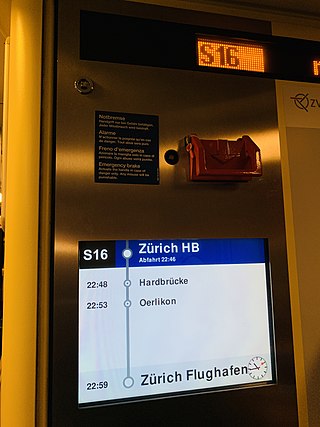
A flat-panel display (FPD) is an electronic display used to display visual content such as text or images. It is present in consumer, medical, transportation, and industrial equipment.

Subpixel rendering is a method used to increase the effective resolution of color matrix displays, such as LCD monitors. It takes advantage of the fact that each pixel is composed of individually addressable red, green, and blue components adjacent on the display matrix, called subpixels, and uses them as rendering units instead of pixels. Subpixel rendering is primarily used for text rendering on standard DPI displays, and isn't as useful for high DPI displays that can natively produce smoother images. Despite the inherent color anomalies, it can also be used to render general graphics.

A backlight is a form of illumination used in liquid-crystal displays (LCDs). As LCDs do not produce light by themselves—unlike, for example, cathode ray tube (CRT), plasma (PDP) or OLED displays—they need illumination to produce a visible image. Backlights illuminate the LCD from the side or back of the display panel, unlike frontlights, which are placed in front of the LCD. Backlights are used in small displays to increase readability in low light conditions such as in wristwatches, and are used in smart phones, computer displays and LCD televisions to produce light in a manner similar to a CRT display. A review of some early backlighting schemes for LCDs is given in a report Engineering and Technology History by Peter J. Wild.
A thin-film-transistor liquid-crystal display is a variant of a liquid-crystal display that uses thin-film-transistor technology to improve image qualities such as addressability and contrast. A TFT LCD is an active matrix LCD, in contrast to passive matrix LCDs or simple, direct-driven LCDs with a few segments.
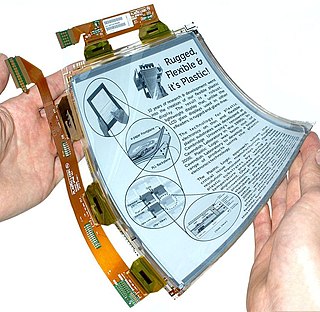
Plastic Logic Germany develops and manufactures electrophoretic displays (EPD), based on organic thin-film transistor (OTFT) technology, in Dresden, Germany.
A blue phase mode LCD is a liquid crystal display (LCD) technology that uses highly twisted cholesteric phases in a blue phase. It was first proposed in 2007 to obtain a better display of moving images with, for example, frame rates of 100–120 Hz to improve the temporal response of LCDs. This operational mode for LCDs also does not require anisotropic alignment layers and thus theoretically simplifies the LCD manufacturing process.
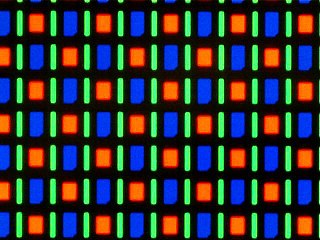
AMOLED is a type of OLED display device technology. OLED describes a specific type of thin-film-display technology in which organic compounds form the electroluminescent material, and active matrix refers to the technology behind the addressing of pixels.
Digital newspaper technology is the technology used to create or distribute a digital newspaper.
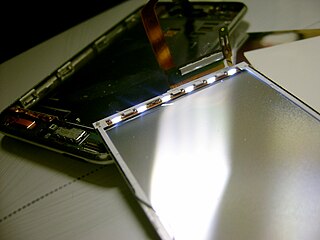
An LED-backlit LCD is a liquid-crystal display that uses LEDs for backlighting instead of traditional cold cathode fluorescent (CCFL) backlighting. LED-backlit displays use the same TFT LCD technologies as CCFL-backlit LCDs, but offer a variety of advantages over them.
The Adam Tablet is a tablet computer designed by Bangalore-based firm Notion Ink Design Labs. The worldwide launch occurred on December 18, 2010 via a video released by Notion Ink detailing their Eden Interface. On December 9 a limited number of devices were released for pre-order globally, followed by a larger pre-order starting January 9, 2011 and an open subscription pre-order from 11 January 2011. The Adam runs a customized version of Android 2.2 Froyo, and has released beta versions of Android 3.0 Honeycomb and Android 4.0 Ice Cream Sandwich The beta versions released were largely done through the efforts of volunteer developers. The Adam is set to be the first Android device marketed to contain Pixel Qi's low-power, dual-mode display. The device is one of several tablet form-factor devices to include a dual-core Nvidia Tegra 2 processor that can support 1080p video output mirroring.
Nanoco Technologies Ltd. (Nanoco) is a UK-based nanotechnology company that spun out from the University of Manchester in 2001. The company's development has been driven by Dr Nigel Pickett, Nanoco's Chief Technology Officer, whose pioneering work on the patented "molecular seeding" process has formed the basis of Nanoco's unique technology. Since 2004, Nanoco has focussed its research efforts into the development and scale-up of quantum dots and other nanoparticles, including cadmium-free quantum dots. Nanoco's technology has been licensed to Dow, Wah Hong, and Merck, amongst others.

XO-3 was a design for a tablet/e-book reader intended to be developed under the One Laptop per Child (OLPC) initiative, but the project was cancelled in November 2012, replaced by the XO tablet.
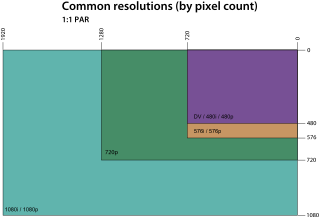
The graphics display resolution is the width and height dimension of an electronic visual display device, measured in pixels. This information is used for electronic devices such as a computer monitor. Certain combinations of width and height are standardized and typically given a name and an initialism which is descriptive of its dimensions. A graphics display resolution can be used in tandem with the size of the graphics display to calculate pixel density. An increase in the pixel density often correlates with a decrease in the size of individual pixels on a display.
Next generation of display technology is any display technology considered likely to outperform current display technology like LCD or OLED.
Universal Display Corporation is a developer and manufacturer of organic light emitting diodes (OLED) technologies and materials as well as provider of services to the display and lighting industries. It is also an OLED research company. Founded in 1994, the company currently owns or has exclusive, co-exclusive or sole license rights with respect to more than 3,000 issued and pending patents worldwide for the commercialization of phosphorescent based OLEDs and also flexible, transparent and stacked OLEDs - for both display and lighting applications. Its phosphorescent OLED technologies and materials are licensed and supplied to companies such as Samsung, LG, AU Optronics CMEL, Pioneer, Panasonic Idemitsu OLED lighting and Konica Minolta.
A see-through display or transparent display is an electronic display that allows the user to see what is shown on the screen while still being able to see through it. The main applications of this type of display are in head-up displays, augmented reality systems, digital signage, and general large-scale spatial light modulation. They should be distinguished from image-combination systems which achieve visually similar effects by optically combining multiple images in the field of view. Transparent displays embed the active matrix of the display in the field of view, which generally allows them to be more compact than combination-based systems.
The Lenovo Miix was a series of multi-mode computing devices that function as both a tablet and a notebook computer.











